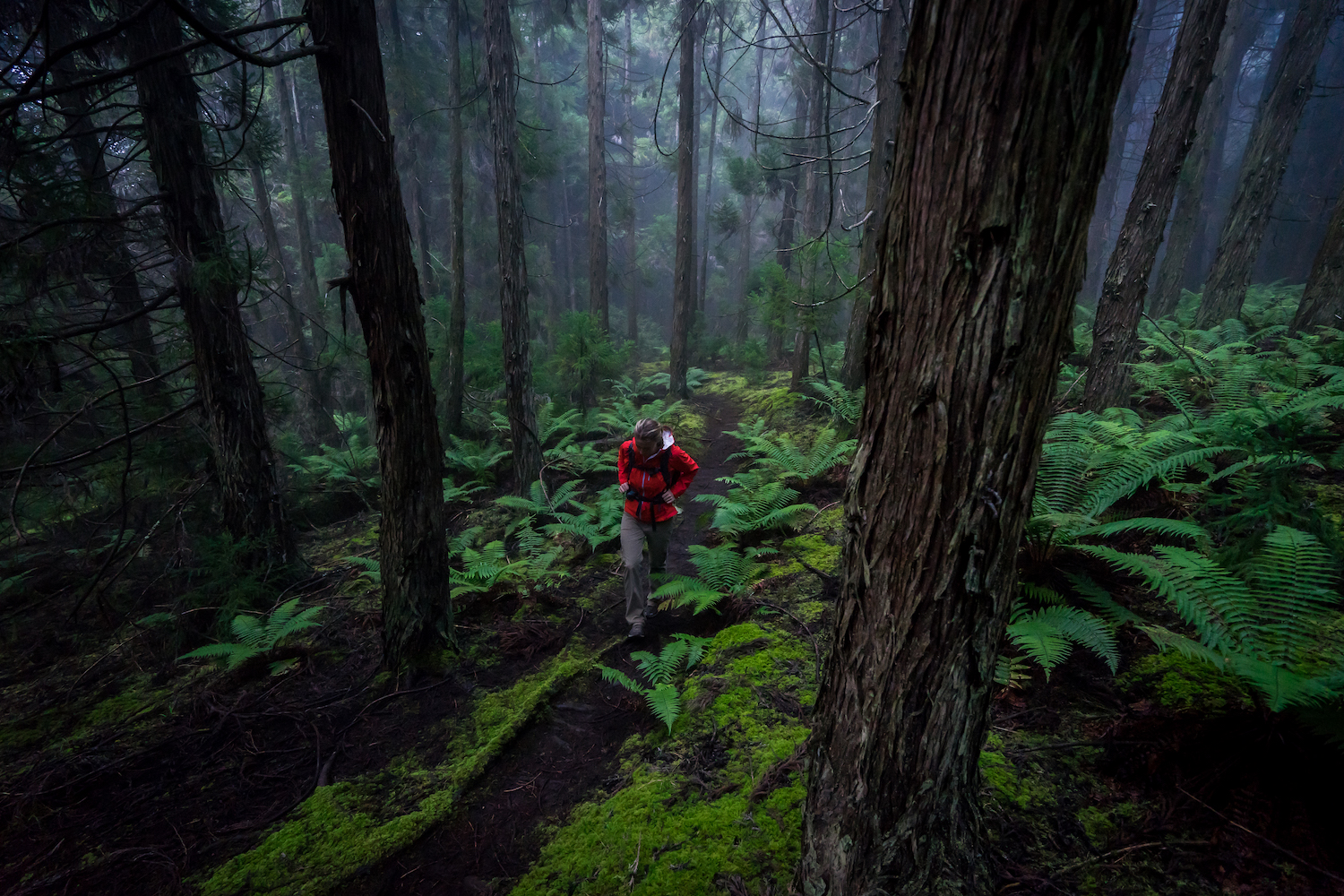Wandering through Polipoli Spring State Recreation Area, while on a hike on Maui, presents redwoods, Hawaiian honeycreepers, and a journey through the past.
Text by Kelli Gratz
Images by Andrew Agcaoili
For an exhilarating hike on Maui, follow the dirt path toward the redwood forest of Polipoli Spring State Recreation Area, the air grows cooler and more foggy, its dewy moisture cooling the skin. At 6,200 feet above sea level, a maze of crisscrossing hiking and biking trails weaves throughout the 21,000-acre Kula and Kahikinui Forest Reserve. Tall, looming redwoods, cedar, cypress, and eucalyptus poke through delicate white wisps of cloud, and for a moment, it’s as if you’re ambling through a forest of conifers in California or Oregon. Then, the cacophony of Native Hawaiian fauna sets in, bringing you right back to upcountry Maui.
Cloud Forest
Resting on the upper slopes of Haleakala, the 10-acre Polipoli Spring State Recreation Area is found at the top of Waipoli Road, tucked away at the end of a primitive dirt path and past several corrugated switchbacks of lava rock. Sometimes referred to as a “cloud forest,” the area is just that, often vanishing into the sky’s misty grey.
The district it resides in, Kula, is particularly historic, harboring some of Hawai‘i’s rarest inhabitants, including several varieties of Hawaiian honeycreepers, such as ‘apapane, Maui ‘alauahio, ‘i‘iwi, and Hawai‘i ‘amakihi. Ancient Hawaiian ruins are scattered throughout the area, as are telltale signs of temporary housing for sandalwood gatherers—all tangible reminders of the living history of old Hawai‘i.
Before departing on hikes, always check weather forecasts and the state website for updates on trails that may be closed.
The land at Polipoli Spring State Recreation Area, which is part of the greater Haleakala National Park, and home to Polipoli Spring—the only permanent source of water on the southern end of the mountain—was once a heavily forested area containing dense native undergrowth.
But starting in the late 1700s, an influx of loggers arrived, looking first for sandalwood to trade in China, then later for koa, ‘ōhia, and other indigenous woods, which were used for everything from railroad ties to building materials. After the trees were nearly gone, the land was worked to grow sugarcane and vegetable crops, or employed as pasture for new plantations or ranches, attributing to further loss in vegetation. In the early 1900s, what was left of the native trees began dying in large numbers due to a fungus.
Around this same time, leaders of government and the sugarcane industry realized that if the degradation of Hawai‘i land continued, there would be no water left, an epiphany leading them to create forest reserves, including those of Haleakala’s higher slopes, which were designated specifically for such restoration.
In fact, it was in 1930 that the redwoods found in the Polipoli Spring State Recreation Area were first planted.
Restoration Effort
Restoration efforts continued with the Civilian Conservation Corps, a federal program created in 1933 by Franklin D. Roosevelt’s administration in order to counter environmental issues, as well as to create labor opportunities during the Great Depression.
In Hawai‘i, the men enlisted were sent to one of numerous camps around the state, including Haleakala, where they worked on a variety of projects including trail construction and reinforcement, infrastructure systems, and tree and plant propagation.
While the workers did attempt to protect and cultivate indigenous trees and plants, researching Haleakala silversword and planting Acacia koa, the majority of the trees introduced were non-native species such as eucalyptus. A 1942 issue of The Honolulu Star Bulletin reported, “About 12,000,000 trees were planted on more than 25,000 acres.”
Want to take the loop trail? Follow Redwood Trail from the Polipoli State Recreation Area to the old Conservation Corps camp, where Plum Trail begins. Follow Plum Trail until it joins Haleakala Ridge Trail, then continue on this until you reach the junction where Polipoli Trail breaks off and leads back to the recreation area.
This new forest of Polipoli thrived until a devastating fire broke out on January 23, 2007. Approximately 1,800 acres were destroyed, leaving only a a few small patches of forest intact and suitable for the sustenance of the ‘apapane and ‘alauahio. (This included the still-existing stand of non-native redwoods).
Restoration Plan
The state’s current restoration plan for Kula Forest Reserve, which Polipoli State Recreation Area lies within, dictates that 65 percent of the replanting consist of native forest species. This has helped to bring the high-elevation forest closer to its original condition, supporting Maui’s native birds, plants, and invertebrates. In addition, the Department of Land and Natural Resources has led massive volunteer tree seedling plantings, working alongside the community to bring life back to these affected areas.
Though the forest’s demographics have changed significantly, the experience of hiking Polipoli is still quite an impressive one. The Polipoli Trail and the Redwood Trail have independent starting points at Polipoli’s campground, where visitors can often be seen pitching a tent or unloading their gear into the single cabin nearby (as of December 2015, the campground facilities were temporarily closed).
When planning a hike on Maui, choose one of these trails, or combine them with the Plum Trail and Haleakala Ridge Trail, two intersecting paths that pass nearby, for a spectacular 3.5-mile loop that spans different climate zones. Observe trees from all over the world, and gasp at scenic panoramas of Haleakala’s southeast face from a lookout point on the Haleakala Ridge Trail.
Maui Creeper
On clear days, there are even views across the Alenuihaha Channel to Hawai‘i Island. The wildlife here may shock you—wild boars, Asian axis deer, ring-necked pheasants, and pueo (owls) call this forest home—and bird purveyors will be delighted to know that the Maui creeper is still abundant. A hike from any point in the reserve leads to another story—another source of life, providing a bridge between old Hawai‘i and new.
Polipoli Spring State Recreation Area is located on Waipoli Road in the Kula Forest Reserve. For directions and more information, visit dlnr.hawaii.gov/dsp/parks/maui/polipoli-spring-state-recreation-area.

